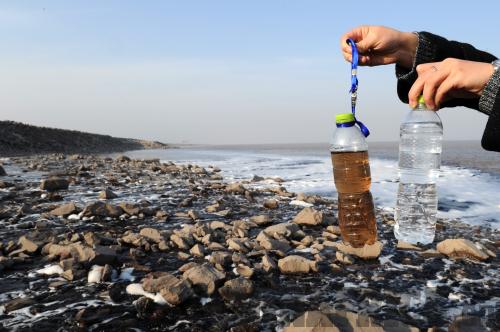|
 |
|
Illicit industrial discharge is the main source of water pollution (JU HUANZONG) |
The world was shocked this March when thousands of pig carcasses were discovered floating in east China's Huangpu River, which provides drinking water to 23 million people. While the exact cause of the hog incident is still under investigation, this issue triggered environmental complaints and concerns among Chinese people, who fear the floating carcasses may lead to water pollution.
A string of pollution issues plaguing the nation this past winter and spring has put the issues of water pollution front and center. At this year's session of the National People's Congress (NPC), China's top legislature, in March, water pollution was a major focus.
It's widely believed that excessive focus on economic interests is behind the severe pollution problem that China is facing. The origins of most major rivers in China are in the western part of the country, a relatively underdeveloped region. "If people in upstream regions are irresponsible about pollution control, the people downstream pay the price," said Li Fengting, a professor of environmental protection at Tongji University in Shanghai.
Cases of cross-provincial pollution have been increasing in recent years, observed Li Yucheng, a professor at Anhui University, who noted that regulators lack authority over enterprises in other provinces under the present administration system, making cooperation a key part of dealing with water pollution issues.
Earlier in January, illicit sewage discharge from industrial enterprises in Henan Province drew media and public attention. The polluted river passes through Anhui Province, and the discharge caused 3 million yuan ($476,190) worth of losses to Anhui fishermen. After the incident, the provincial governments of Henan and Anhui formulated a plan to cooperate. In addition to treating the polluted water and supervising water quality, Henan took responsibility for the pollution and paid 4 million yuan ($634,920) in compensation to the affected area in Anhui.
Besides a measure dictating that polluters pay the costs to purify polluted water, a more extensive ecological compensation system to curb water pollution is being promoted throughout China. The central government has been highlighting this idea since 2011. "Upstream areas must take more stringent environmental protection measures through reasonable planning, layout optimization and industrial structure adjustment to create a friendly environment for the economic development of areas downstream," explained Li. "Meanwhile, downstream areas should contribute funds and offer preferential policy to upstream areas. The system will help both areas benefit and advance scientific development."
Deeper problems
The first Communique on Water Resources released by the Ministry of Water Resources on March 26 reports that, over the past two decades, 27,000 rivers have dried up in China, about half of the nation's total, and that the nation's water pollution problem is severe.
But water problems in China go even deeper. A recent investigation of groundwater quality on the North China Plain shows that only 20 percent of groundwater in the region is safe to drink untreated.
Household sewage and industrial discharge are the main sources for groundwater pollution. And the problem is exacerbated by illegal waste disposal practices, as allegedly seen in Weifang City in Shandong Province. In February, online reports claimed that companies in the area were digging deep wells to dispose of industrial chemical waste. When rivers and groundwater get increasingly polluted, people have to dig deeper to find clean drinking water, which has caused overexploitation problems in over 60 cities throughout China.
"Overexploitation can lead to a cone of groundwater depression. The North China Plain, for example, has the biggest cone in the world," said Ma Jun from the Institute of Public and Environmental Affairs, an NGO based in Beijing. "People have to dig deeper and deeper. It's a vicious cycle."
|